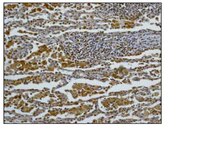04-1014 Sigma-AldrichAnti-STAT3 Antibody, clone E121-21, rabbit monoclonal
Please note that this product will not be available for sale after March 15, 2015. Please select one of the other antibodies against this target.
More>> Please note that this product will not be available for sale after March 15, 2015. Please select one of the other antibodies against this target. Less<<Produits recommandés
Aperçu
| Replacement Information |
|---|
Tableau de caractéristiques principal
| Species Reactivity | Key Applications | Host | Format | Antibody Type |
|---|---|---|---|---|
| H | WB, ICC, IH(P), IP | Rb | Unpurified | Monoclonal Antibody |
| References |
|---|
| Physicochemical Information |
|---|
| Dimensions |
|---|
| Materials Information |
|---|
| Toxicological Information |
|---|
| Safety Information according to GHS |
|---|
| Safety Information |
|---|
| Packaging Information | |
|---|---|
| Material Size | 100 µL |
| Transport Information |
|---|
| Supplemental Information |
|---|
| Specifications |
|---|
| Global Trade Item Number | |
|---|---|
| Référence | GTIN |
| 04-1014 | 04053252729881 |
Documentation
Required Licenses
| Title |
|---|
| PRODUCTO REGULADO POR LA SECRETARÍA DE SALUD |
Anti-STAT3 Antibody, clone E121-21, rabbit monoclonal FDS
| Titre |
|---|
Anti-STAT3 Antibody, clone E121-21, rabbit monoclonal Certificats d'analyse
Brochure
| Titre |
|---|
| Advancing cancer research: From hallmarks & biomarkers to tumor microenvironment progression |
Informations techniques
| Titre |
|---|
| JAK/STAT Signaling Research Focus |








